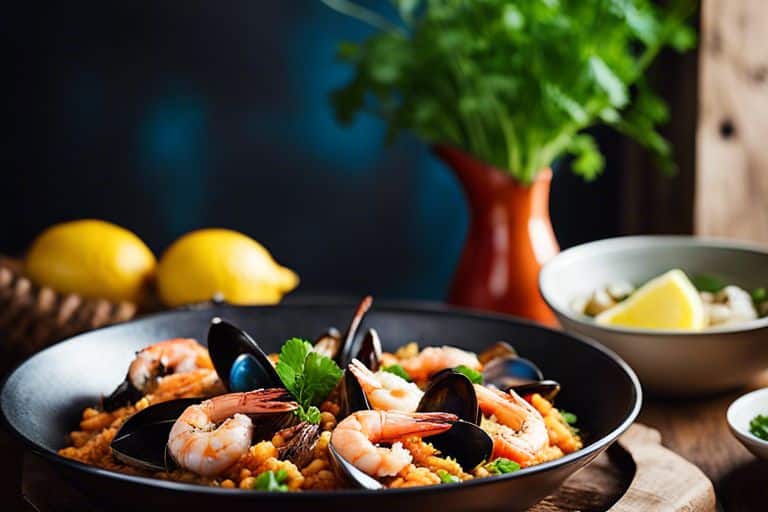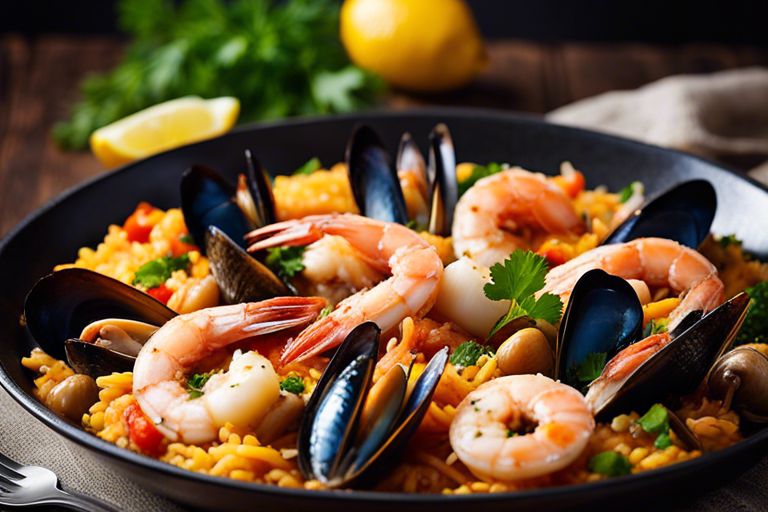It’s time to elevate your culinary skills and explore into the delicious world of Spanish cuisine with the iconic seafood paella. This classic dish originates from Valencia and is known for its vibrant colors, bold flavors, and aromatic spices. If you want to impress your guests at your next dinner party or simply enjoy a taste of Spain in the comfort of your own home, mastering the art of Spanish seafood paella is a must. Follow along as we guide you through the important ingredients, traditional cooking techniques, and helpful tips to create a perfect paella every time.
Key Takeaways:
- Traditional Ingredients: To master the art of Spanish seafood paella, it is imperative to use traditional ingredients such as bomba rice, saffron, smoked paprika, and a variety of seafood like shrimp, mussels, and squid.
- Technique is Key: The key to a perfect paella lies in the technique. From creating a flavorful sofrito as a base to achieving the desired socarrat (crispy rice crust) at the bottom of the pan, mastering the technique is crucial.
- Presentation Matters: Presentation is an imperative element of Spanish cuisine. Serve your paella in a traditional paella pan, garnish with lemon wedges and fresh parsley, and enjoy this iconic dish with family and friends.
Ingredients for Authentic Spanish Seafood Paella
While there are many variations of paella, an authentic Spanish Seafood Paella is a true delight for the senses. The key to creating the perfect paella lies in the careful selection of fresh ingredients and the right combination of spices and seasonings.
The Essential Seafood Selection
Seafood plays a starring role in a traditional Spanish Seafood Paella. The selection of seafood can vary, but common choices include shrimp, mussels, clams, and squid. The freshness of the seafood is crucial to the dish’s overall flavor, so be sure to source the best quality ingredients available. The combination of different types of seafood creates a rich and complex flavor profile that is simply irresistible.
When selecting seafood for your paella, look for ingredients that are firm, shiny, and have a mild ocean scent. It’s also important to clean and prepare the seafood properly before adding it to the dish. This ensures that you get the best possible flavor and texture in your paella.
Key Spices and Seasonings
Ingredients such as saffron, paprika, and garlic are imperative for creating the distinctive flavor of Spanish Seafood Paella. Saffron, in particular, adds a unique earthy aroma and a rich golden color to the dish. The combination of sweet and smoked paprika provides depth and complexity, while garlic adds a bold and savory note to the paella.
Seasonings play a crucial role in enhancing the natural flavors of the seafood and rice in the dish. Proper seasoning with salt and pepper is key, as it helps to balance the flavors and bring out the best in each ingredient. Additionally, a touch of lemon juice or a sprinkle of fresh herbs can add a bright and zesty finish to your Spanish Seafood Paella.
The Perfect Paella Pan
Some say that the key to a perfect Spanish seafood paella lies in the pan used to cook it. Choosing the right paella pan can make all the difference in the flavor and presentation of this iconic dish. In this chapter, we will research into the important aspects to consider when selecting the perfect paella pan for your culinary creations.
Traditional Styles and Materials
Materials play a significant role in the performance of a paella pan. Traditional paella pans are typically made of carbon steel, which distributes heat evenly and develops a natural non-stick coating over time. Some pans come with a dimpled base that helps distribute heat more evenly, ensuring that your paella cooks to perfection without burning.
Other common materials used for paella pans include stainless steel and enamel. While these materials may be easier to clean, they may not offer the same heat conduction properties as carbon steel, impacting the final result of your paella. Choosing a pan made from traditional materials will ensure an authentic and delicious paella every time.
Size and Handling
One crucial factor to consider when selecting a paella pan is its size. The size of the pan will not only determine the number of servings you can prepare but also impact the cooking time and overall texture of the dish. Paella pans come in various sizes, ranging from small pans suitable for two servings to large pans meant for feeding a crowd.
It is important to choose a pan that allows the rice to cook in a thin, even layer to achieve the perfect socarrat, the caramelized crust at the bottom of the paella. Additionally, a pan with sturdy handles will make it easier to transport from the stovetop to the table. Consider the number of guests you typically cook for and the stovetop size when selecting the right paella pan for your kitchen.
It is crucial to invest in a high-quality paella pan made from traditional materials to ensure the best results when cooking this iconic dish. Consider the size and handling of the pan to make sure it meets your cooking needs and allows for the perfect preparation of Spanish seafood paella every time.
Mastering the Technique
Keep in mind that mastering the art of Spanish seafood Paella requires attention to detail and a deep understanding of the techniques involved. It’s not just about throwing ingredients together in a pan; it’s about layering flavors and managing the cooking process to achieve the perfect balance of taste and texture.
The Art of Layering Flavors
The key to a delicious Paella lies in the art of layering flavors. Start by sautéing your aromatics – onions, garlic, and bell peppers – in olive oil until they are soft and fragrant. Next, add your spices such as saffron, paprika, and a pinch of cayenne for some heat. This will create a flavorful base for your dish.
Layering flavors also involves adding ingredients in a specific order to ensure they cook properly and infuse the dish with their unique taste. For example, adding seafood towards the end of the cooking process will prevent it from becoming tough and overcooked, allowing it to shine in your Paella.
Managing the Cooking Process
Layering flavors is imperative, but managing the cooking process is equally important in mastering the art of Spanish seafood Paella. Timing is critical when adding ingredients to the pan – from the rice to the broth to the seafood. Each component requires careful attention to ensure they are cooked to perfection.
For instance, you’ll want to add the rice and broth to the pan first, allowing the rice to absorb the flavors of the broth as it cooks. Once the rice is nearly done, you can add your seafood on top to gently steam and cook in the flavorful broth. This method ensures that every bite is packed with delicious taste and the seafood remains tender.

Variations and Accompaniments
For those who have already mastered the art of crafting a traditional Spanish seafood paella, it’s time to explore the world of variations and accompaniments that can elevate this dish to new heights. Whether you’re looking to add a regional twist or find the perfect side dish and wine pairing, there are endless possibilities to make your paella experience even more unforgettable.
Regional Twists on Classic Paella
One of the joys of Spanish cuisine is the regional diversity that shines through in every dish, and paella is no exception. From the rich and indulgent Valencian paella with rabbit and snails to the vibrant and flavorful Catalonian fideuà made with noodles instead of rice, each region offers its own unique take on this iconic dish. Don’t be afraid to experiment with different ingredients and techniques to create a paella that reflects your favorite Spanish culinary traditions.
For a taste of the sea, consider trying the Andalusian seafood paella packed with fresh fish, clams, and shrimp, or venture towards the Basque Country for a hearty mix of chorizo and peppers in your paella. Bear in mind, the key to a successful regional twist lies in using fresh, high-quality ingredients and staying true to the authentic flavors of each region.
Ideal Side Dishes and Wine Pairings
Dishes
Any seafood paella aficionado knows that the perfect side dish and wine pairing can take a good meal to a great one. When considering choosing the ideal accompaniments for your paella, think about complementing the flavors and textures of the dish. Crusty bread with aioli, a refreshing green salad, or grilled vegetables can provide a delightful contrast to the rich and savory paella.
To wrap up
With this in mind, mastering the art of Spanish seafood paella is a rewarding journey that requires practice, patience, and attention to detail. By following tradition while allowing yourself to experiment with ingredients and techniques, you can create a dish that truly captures the essence of Spanish cuisine. Whether you are a seafood lover or a culinary enthusiast, perfecting your paella-making skills will surely impress your friends and family. So, gather your ingredients, fire up the stove, and launch on a flavorful adventure that celebrates the rich flavors and vibrant colors of Spanish seafood paella.
FAQ
Q: What is Spanish Seafood Paella?
A: Spanish Seafood Paella is a traditional Spanish dish consisting of saffron-infused rice cooked with a variety of seafood such as shrimp, mussels, clams, and sometimes fish. It is typically cooked in a large, shallow pan and is seasoned with a combination of garlic, onions, tomatoes, and spices.
Q: What are the key ingredients needed to make Spanish Seafood Paella?
A: The key ingredients needed to make Spanish Seafood Paella include short-grain Spanish rice, saffron threads, seafood such as shrimp, mussels, and clams, garlic, onions, tomatoes, chicken or fish broth, olive oil, and a variety of spices like paprika and cayenne pepper.
Q: What are some tips for mastering the art of cooking Spanish Seafood Paella?
A: To master the art of cooking Spanish Seafood Paella, it is important to use the right type of rice, such as bomba or Calasparra rice, as they absorb more liquid and remain firm during cooking. It is also imperative to use high-quality saffron and fresh seafood for the best flavor. Additionally, make sure to cook the paella over medium heat and resist the urge to stir it too often to develop the coveted socarrat, the caramelized crust that forms on the bottom of the pan.

